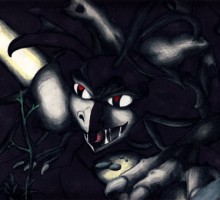Darkness swirls around, heavy as the great stone slabs of the prison, cold and rough under your feet. Straw cracks as you lean forward, the hair of your neck lifting. You freeze again, slivers of moonlight from the barred window pooling along the blade of your sword like white fire.
You’re not alone.
Can you picture it? Sight, touch, sound. The white space of the blank page painted with words to create an illusion of setting, a set built not on any stage, but in the walls of the reader’s mind.
But as words are necessary to paint it, so they are also necessary to keep it in place. Or else it starts to fade, disappearing in the reader’s mind, even if action and dialogue continues, until the scene seems somehow unrealistic, disembodied voices and actions floating in a void. Which isn’t to say you’ll necessarily lose the reader’s interest. The reader may still be fascinated with your voices and actions, the twists of plot. But what you do lose is the illusion of reality, the suspension of disbelief. And the reader’s connection to the story will start to diminish, their worries and tensions recede, because the stakes seem less real.
The power of the story drains away, almost unnoticed.
So what can you do? It’s actually pretty easy, once you know what to look for it. Dab a few fresh splatters of paint here and there, bolster the walls and floors, turn on the wind machine. Keep your characters firmly anchored on the stage you’ve built, and don’t let them drift into empty space.
Not that there aren’t risks. Because if you spend too much time fixing your stage, having your handyman run around painting walls and plugging in wind machines, the story is going to slow. Pace slackens. Tension diminishes. And you’ve lost the reader again, albeit in a different way.
It’s a balance. So how do you know how much setting work to do and when?
I wish I had a better answer, but I think it’s feel.
You are your story’s first reader, an experienced reader, and—in my experience–your gut should twinge. There are spaces when action slackens, or the background changes, and it just feels natural to touch up the set.
Despite my vague answer, I actually think that this is one of those things that is easy to get right, as long as you’re watching for it. If you put a little care into your story, and make this a box to check in one of your revision passes, I think you should be fine. Which is good, because then you can focus on the action.
Because…
With a howl, a beast explodes from the darkness. Claws flash. Pain burns your wrist and the sword spins away, swallowed by darkness. The cold wall smashes into your back, even as your fingers plunge desperately into a furred throat…
Action’s the fun part. So keep your paint fresh and enjoy it….
This image is also old, from the teenage years. I liked to play with light and shadow, and actually wouldn’t mind getting back into it now. I was going to do a new image for the post, but ran out of time, and this one didn’t seem too far removed, so here we are. I’m starting to have more draft posts than appropriate images, so there may be the odd mismatch until I have some more generic paintings worked up to bridge the gaps… As usual, we’ll figure it out…

